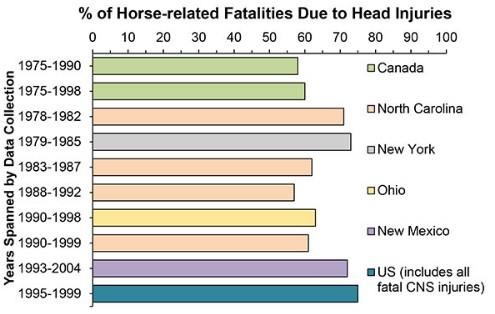By Sara Mastellar
Equestrian sports can be enjoyed throughout a lifetime with athletes continuing in their sport well beyond when many athletes have given up their high school sports. For example, the oldest US Olympian that competed in the 2016 Rio Olympics was 52-year-old equestrian Phillip Dutton (Delzo, 2016). With older individuals choosing horseback riding as their hobby of choice some equestrian sports have the reputation of being low key, low risk sports. As a result, potential risk and safety considerations may be overlooked. This article provides an overview of some key statistics on horse-related injuries to humans.
Relative Risk
On a total injury basis, horseback riding can be compared to other sports on an hours of participation basis (Table 1). Data on rodeo injuries were collected on a competitor exposures basis making it not directly comparable to other sports.
Table 1. Relative risk of horseback riding compared to selected sports
| Sport | Injuries
(per 1000 hrs of participation) |
| American football* | 10-35 |
| Basketball | 9.1 |
| Ice hockey | 7.5 |
| Karate | 6.7 |
| Baseball** | 1.6-5.8 |
| Downhill skiing | 4.1 |
| Horse riding | 3.7 |
| Cycling | 2.0 |
| Swimming | 1.0 |
| Golf | 0.3 |
| Rodeo event | Injuries
(per 1000 competitor exposures) |
| Bull riding*** | 141 |
| Bronc riding (bareback)*** | 72 |
| Bronc riding (saddle)*** | 63 |
| Steer wrestling*** | 50 |
| Calf roping*** | 8 |
| Ladies barrel racing*** | 6 |
Horse-Related Injuries
Compared to the American pastimes of football, basketball, and baseball, the injury rate for horse riding is relatively low. However, several studies have found that horse-related injuries presented at hospitals tend to be severe. A side by side comparison of horseback riding and hockey found that horseback riding related injuries were more likely to require hospitalization. Of common childhood injuries, only being struck by a car had a higher severity score than equestrian-related injuries. Additionally, studies have found that the average hospitalization for an equestrian related injury (including head injuries) is 5-6 days. Head injuries are of particular concern due to their severity. Approximately 10-30% of horse-related injuries are head injuries. In fact, of all sports in the US, equestrian sports are the most common cause of sports-related traumatic brain injury (TBI) in adults.
Statements such as “everyone falls off” and “you aren’t a real rider until you’ve fallen off” abound in the horse industry. While these statements are often used to encourage novice riders to not give up the first time they fall, the data shows that not just falls, but injuries are likely to happen. The data agrees that injuries are likely to happen at some point in a rider’s career. A survey of riders in Oregon, Washington, and Idaho states found that 81% were injured at some point in their riding career and that 21% were injured seriously (requiring hospitalization/surgery or causing long term disability).
Fortunately, horse-related fatalities are relatively few. For example, horses were involved with the deaths of 43 people in New Mexico between 1993 and 2004, a span of 11 years. For comparison, 298 fatalities were due to car crashes in New Mexico during 2015 alone. Over the decades approximately 60-70% of horse-related fatalities have been due to head injuries (Figure 1). Other factors involved in horse-related fatalities included spine injuries, crushing injuries, and the involvement of an automobile.

Figure 1. Summary of data collected in various studies on the percentage of horse-related fatalities due to head injuries. Data from Aronson & Tough, 1993; Sorli, 1999; Hammet, 1994; Malavase, 1994; Koephi, 2000; Lathrop, 2007; and Ghosh et al., 2000.
Experience & Risk of Injury
Researchers report conflicting evidence as to whether experience or number of years riding reduces injury rates. A study conducted in Oregon, Washington, and Idaho found that novice riders are the most likely to be injured (Mayberry et al., 2007). The same was true of a study completed in Hong Kong (Yim et al., 2007). Additionally, recreational riders had higher rates of injury than professional equestrians in Australia (Lim et al., 2003). These findings suggest that inexperienced riders are more at risk.
However, more experienced riders may take on more challenging mounts and activities which increases injury risk. The average years of riding experience for Canadian adults admitted to a trauma center for severe horse-related injuries was 27 yrs as determined from a 10 year study (Ball, Ball, Kirkpatrick, & Mulloy, 2007). Also, data collected in Austin, Texas, found that inexperienced dudes accounted for 38% of the livestock-injured patients, while ranchers and cowboys accounted for 43% of livestock-injured patients (Criddle, 2001). It is important to remember that accidents can happen to anyone, regardless of their level of experience.
Click here to see more...